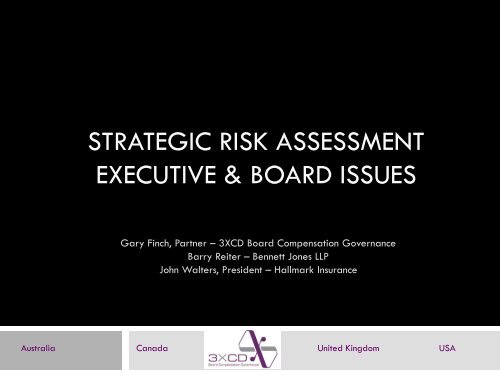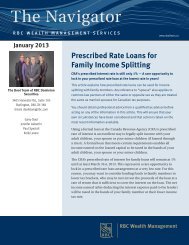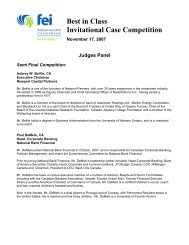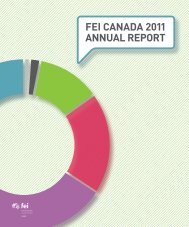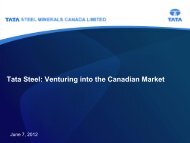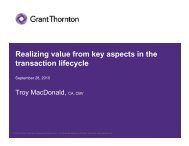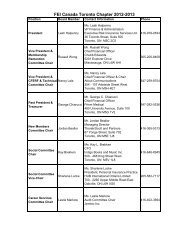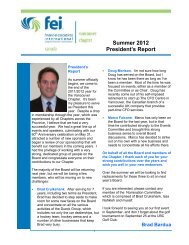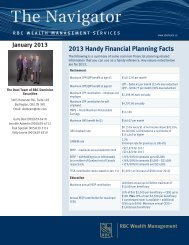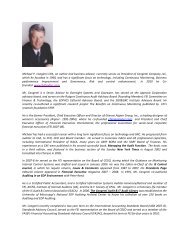STRATEGIC RISK ASSESSMENT EXECUTIVE & BOARD ISSUES
STRATEGIC RISK ASSESSMENT EXECUTIVE & BOARD ISSUES
STRATEGIC RISK ASSESSMENT EXECUTIVE & BOARD ISSUES
Create successful ePaper yourself
Turn your PDF publications into a flip-book with our unique Google optimized e-Paper software.
<strong>STRATEGIC</strong> <strong>RISK</strong> <strong>ASSESSMENT</strong><br />
<strong>EXECUTIVE</strong> & <strong>BOARD</strong> <strong>ISSUES</strong><br />
Gary Finch, Partner – 3XCD Board Compensation Governance<br />
Barry Reiter – Bennett Jones LLP<br />
John Walters, President – Hallmark Insurance<br />
Australia Canada United Kingdom USA
Strategy and Risk<br />
• The Board of Directors role has changed dramatically since 2005.<br />
• Boards have to become more fully engaged is both strategy and risk.<br />
• Both strategy and risk impact and drive significant business and pay decisions.
Share Price ($ CDN)<br />
Nortel Overview<br />
• Nortel is a large multinational listed on the TSX and NYSE.<br />
• The industry experienced a significant downturn - industry consolidation.<br />
• Company was hardest hit; failure to meet revenue targets – falling share price.<br />
900<br />
800<br />
700<br />
600<br />
500<br />
400<br />
300<br />
200<br />
100<br />
0
Timeline - Year 1 to Year 3<br />
Nortel did experience accounting irregularities and did<br />
restate financials twice.<br />
Share price plummets, industry<br />
consolidation.<br />
Nortel still “free-standing”.<br />
Year 1 Year 2 Year 3
Nortel’s Executive Compensation<br />
• HRCC retained two compensation consultants.<br />
Attract, motivate and retain key talent using Base, STIP, MTIP and LTIP.<br />
• Competitively compensate executives for total performance and contribution.<br />
Benchmark base salary to 23 comparator companies. ($1M)<br />
Examine performance and pay (annual revenues or number of employees).<br />
• Total pay was targeted at the 50th to 75th percentile range of the comparator group.<br />
Actual position of<br />
Nortel versus their<br />
Comparator Group<br />
Currently 19 th of 23.
Executive Compensation Approach<br />
• Compensation includes:<br />
Base salary for CEO $1.0 million<br />
STIP Plan: (STIP)<br />
• Base salary x target % x individual factor x corporate performance.<br />
• Corporate performance: revenue (25%), EBIT (50%), and cash<br />
flow (25%), it may include customer satisfaction.<br />
LTIP Plan – stock trades at $30.<br />
• Stock Options are 10 year term, 4 year annual vest. (LTIP)<br />
• Base salary x 2 for number of options.<br />
• Stock grant is 3 year term, annual vest. (MTIP)<br />
• Base salary x 1.5 for number of units.<br />
• Performance stock grants based on 3 year cliff vest. (MTIP)<br />
• Base salary x 2 for target performance.<br />
• At 20th position or below – 50% of grant.<br />
• At 15th position or below – 100% of grant.<br />
• At 10th position or below – 150% of grant<br />
• In top 3 – 200% of grant.
Nortel – Summary of Board Risk Assessment<br />
Med-Co - Summary of Board Risk Assessment<br />
Financial Markets Risk Summary<br />
Positive 1-year TSR?<br />
Positive 3-year TSR?<br />
3-year TSR > flat Bond Rate?<br />
After tax ROIC greater than COC?<br />
Maintained current market value?<br />
Positive 12-month stock price volatility?<br />
Is ROIC > average competitor ROIC?<br />
Is EPI > median competitors EPI?<br />
Company EPI vs. EPI of competitors?<br />
Executive Leadership Risk<br />
Has Board developed CEO role/skills profile?<br />
Does CEO/NEO detailed succession process exist?<br />
Are succession plans in place for CEO/NEO?<br />
Board engages w ith CEO & key management?<br />
Has Board developed CEO performance program?<br />
Skills for >5 roles identified in business strategy?<br />
Has exec talent been assessed for the above roles?<br />
Performance Based CEO Compensation<br />
Does HRCC meet perf-based comp guidelines?<br />
Are qualitative measures disclosed in STIP?<br />
Did EC decisions use 3-yr TDC vs Perf analysis?<br />
Did PFP decisions consider 3-year profitability?<br />
Is there a defensible comp calibration process?<br />
Is EC theoretically linked to strategic development?<br />
Does EC actually like to strategic development<br />
Organizational Structure and Enterprise Risk Management<br />
CEO Op Performance Eval > 1 – 2 years?<br />
Mgmt perf measures on Innovation & Planning?<br />
Does a documented ERM process exist?<br />
Is ERM process implemented & under review ?<br />
Risk assessment assigned to each Board committee<br />
Annual risk assessment on each Board committee<br />
Board understands & acknow ledges the ERP<br />
Board discloses major risks & findings w ith execs<br />
Board confident in corp disaster recovery process<br />
1 2 3 4 5 1 2 3 4 5<br />
Board Assessment<br />
Board has created effective meeting procedures<br />
Board has stated its strategic duty to shareholders<br />
Board is continually involved in mission & strategy<br />
Board assesses w orkplace safety for employees<br />
Corp governance practices released to shareholders<br />
Board disclosure of “in-camera” sessions<br />
Board meets disclosure guidelines of regulators<br />
1 2 3 4 5 Board participates in key decision issues<br />
New directors receive adequate strategic induction<br />
Director election process is appropriate & effective<br />
Board more effective through utilization of directors<br />
Chair provides leadership for Board and CEO<br />
Board members appropriately prepared for meetings<br />
Board analyses & improves its ow n performance<br />
Board compares ow n performance w ith peers<br />
2 or less active CEOs are sitting on the Board<br />
CEO's sitting on the HRCC<br />
1 2 3 4 5 1 2 3 4 5
Role of Risk<br />
• Insight on strategy and risk are critical for Board of Directors to meet their duties:<br />
Fiduciary Duty, Duty of Care, Duty of Loyalty, and Duty of Obedience<br />
<br />
Crowns/Privates – where is governance going?<br />
• The linkage between strategy and risk, to business drivers and incentive drivers<br />
sometimes appears overlooked.<br />
• When strategy and risk are not clearly known, business drivers cannot be<br />
determined, and incentive plan design includes significant errors.<br />
83% - 87%
Issues of Risk<br />
13% -17%<br />
83% - 87%<br />
Financial Risk<br />
• “Typically” well managed<br />
• Process:<br />
•Internal Audit<br />
•External Audit<br />
•Audit Committee<br />
•Board of Directors<br />
• Most Boards feel comfortable.<br />
• Audit committee is independent<br />
and has sound financial<br />
understanding.<br />
Source – The Directors College<br />
Non-Financial Risk<br />
• Partially overlooked as not well managed like financial risk.<br />
• Includes: Strategic, cyclical, acquisition, capital, and leadership risks.
Developing Understanding of Risk<br />
• Definition of Risk by Board/Management.<br />
Has this been discussed?<br />
• Board’s understanding of Risk Appetite<br />
Does the Board understand Risk and Risk Appetite at your company?<br />
• Types of Corporate Risk the Board of Directors must be cognizant of:<br />
Strategic Risk<br />
Cyclical Risk<br />
Acquisition Risk<br />
Capital Structure Risk<br />
Leadership Risk
Risk and Risk Assessment<br />
Where do Boards and Executives sit?<br />
• Sound governance practices demand that Boards seek out and minimize risk<br />
wherever possible.<br />
How do we know the risks?<br />
Risk assessments – how is your company doing?<br />
• Committees are less confident in the oversight of other significant business risks<br />
and in the coordination of risk oversight activities with rest of the Board.<br />
How does this get managed at your company?<br />
• Boards have greater appreciation for the need to understand the quality of their<br />
companies risk profile, risk appetite, and risk intelligence<br />
Have these topics been discussed with your executive and Board?<br />
Are these discussions “continuous”?
Understanding of Risk<br />
Significant Issue<br />
• Understanding of Risk is critical – to Board and Executives!<br />
• From our experience and assessments, understanding of risk is all over the map!<br />
Why?<br />
Who owns risk in the corporation?<br />
• Is it executive, Board or both?<br />
<br />
<br />
• How is information transferred?<br />
What happens to the reports developed for the Board?<br />
What is the “true” dynamic between the executive and the Board on Risk?
Example 2.<br />
US and Canadian Property Company - Private<br />
• Sophisticated Board with exceptional top level executives.<br />
• Corporation operates activities in numerous countries.<br />
• Board completed assessment, as did executives, neither group (or individuals within<br />
either group) could agree on strategic direction or risk?<br />
Why?.<br />
What are the answers to managing executive to Board risk?<br />
How can this be fostered at the executive and Board level?
Closing the Gap<br />
Internal Risk and the Board<br />
• Determine the split for the responsibility of Risk Assessment.<br />
Monitoring risk<br />
among the audit<br />
committee<br />
Management’s self<br />
risk assessment<br />
programs<br />
Internal and external<br />
auditor roles for risk<br />
assessment<br />
• Where does Internal Risk process feed into Board Risk?<br />
• Is communication strategy between Board and Executive on Risk<br />
appropriate?<br />
• Is there a way to better develop this integrated initiative?
Summary Observations<br />
• Executive oversight and risk management by boards is a key responsibility –<br />
and is often, not well done. (Surveys prove this)<br />
• We have seen some techniques for assisting boards with their task of<br />
managing risk. There may be others - we have not found them.<br />
• We have shown examples of the result of Boards attempting to help<br />
understand and manage risk. The BOD may do everything right and the<br />
“wheels still fall-off”. How do we work through this issue effectively?<br />
• We have discussed one example that offers a mechanism for determining<br />
the responsibility for risk assessment. There may be others.<br />
• Where does your organization fit on the spectrum of risk assessment?
John Walters<br />
4 Lansing Square, Suite 100<br />
Toronto, Ontario<br />
M2J 5A2<br />
Phone: 416-492-4070<br />
Fax: 416-492-4321<br />
Gary Finch<br />
1 Yonge Street, Suite 1801<br />
Toronto, Ontario,<br />
M5E1W7<br />
Phone: 416-214-7831<br />
Fax: 416-369-0515<br />
3XCD Data Centre<br />
4 Lansing Square, Suite 206<br />
Toronto, Ontario,<br />
M2J 5A2<br />
Phone: 416-493-1869<br />
Fax: 416-493-1864<br />
Barry Reiter<br />
3400 One First Canadian Place<br />
P.O. Box 130<br />
Toronto, Ontario<br />
M5X 1A4<br />
Phone: 416-863-1200<br />
Fax: 416-863-1716


